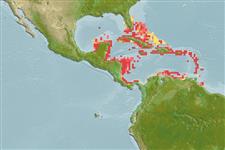>
Blenniiformes (Blennies) >
Blenniidae (Combtooth blennies) > Salariinae
Etymology: Entomacrodus: Greek, ento = inside + Greek, makros = big + Greek, odous = teeth (Ref. 45335).
More on author: Gill.
Environment: milieu / climate zone / depth range / distribution range
Ökologie
seewasser riff-verbunden; tiefenbereich 0 - 6 m (Ref. 9710), usually 0 - 3 m (Ref. 13628). Tropical; 32°N - 7°N, 92°W - 59°W
Western Atlantic: Bermuda, southern Florida (USA), and Bahamas to northern South America.
Size / Gewicht / Alter
Maturity: Lm ? range ? - ? cm
Max length : 10.0 cm TL Männchen/unbestimmt; (Ref. 7251)
Rückenflossenstacheln (insgesamt) : 13; Rückenflossenweichstrahlen (insgesamt) : 14 - 15; Afterflossenstacheln: 2; Afterflossenweichstrahlen: 15 - 17; Wirbelzahl: 34. Olivaceous with 7 short dark brown double bars on side of body and rows of small pale blue spots (Ref. 13442).
Facultative air-breathing (Ref. 126274); Adults occur in intertidal areas (Ref. 31184), like tide pools, rocky slopes, and places where there are boulders on the bottom (Ref. 5521). Actively shuttle back and forth between rock-pools and air (Ref. 31184). They breathe air (Ref. 31184) and can remain out of water for up to 2 hours if kept moist (Ref. 51276). Feed mainly on algae (Ref. 13442). Oviparous. Eggs are demersal and adhesive (Ref. 205), and are attached to the substrate via a filamentous, adhesive pad or pedestal (Ref. 94114). Larvae are planktonic, often found in shallow, coastal waters (Ref. 94114).
Life cycle and mating behavior
Maturities | Fortpflanzung | Spawnings | Egg(s) | Fecundities | Larven
Oviparous, distinct pairing (Ref. 205).
Robins, C.R. and G.C. Ray, 1986. A field guide to Atlantic coast fishes of North America. Houghton Mifflin Company, Boston, U.S.A. 354 p. (Ref. 7251)
IUCN Rote Liste Status (Ref. 130435)
Bedrohung für Menschen
Harmless
Nutzung durch Menschen
Fischereien: nicht kommerziell; Aquarium: Kommerziell
Tools
Zusatzinformationen
Download XML
Internet Quellen
Estimates based on models
Preferred temperature (Ref.
123201): 26.5 - 28.2, mean 27.5 °C (based on 532 cells).
Phylogenetic diversity index (Ref.
82804): PD
50 = 0.5000 [Uniqueness, from 0.5 = low to 2.0 = high].
Bayesian length-weight: a=0.00741 (0.00335 - 0.01640), b=3.02 (2.83 - 3.21), in cm total length, based on LWR estimates for this (Sub)family-body shape (Ref.
93245).
Trophic level (Ref.
69278): 2.0 ±0.0 se; based on diet studies.
Widerstandsfähigkeit (Ref.
120179): hoch, Verdopplung der Population dauert weniger als 15 Monate. (Preliminary K or Fecundity.).
Fishing Vulnerability (Ref.
59153): Low vulnerability (10 of 100).
Nutrients (Ref.
124155): Calcium = 165 [80, 291] mg/100g; Iron = 0.868 [0.480, 1.563] mg/100g; Protein = 17.9 [16.7, 19.1] %; Omega3 = 0.0751 [, ] g/100g; Selenium = 20 [9, 47] μg/100g; VitaminA = 114 [27, 469] μg/100g; Zinc = 2.71 [1.75, 4.02] mg/100g (wet weight);
